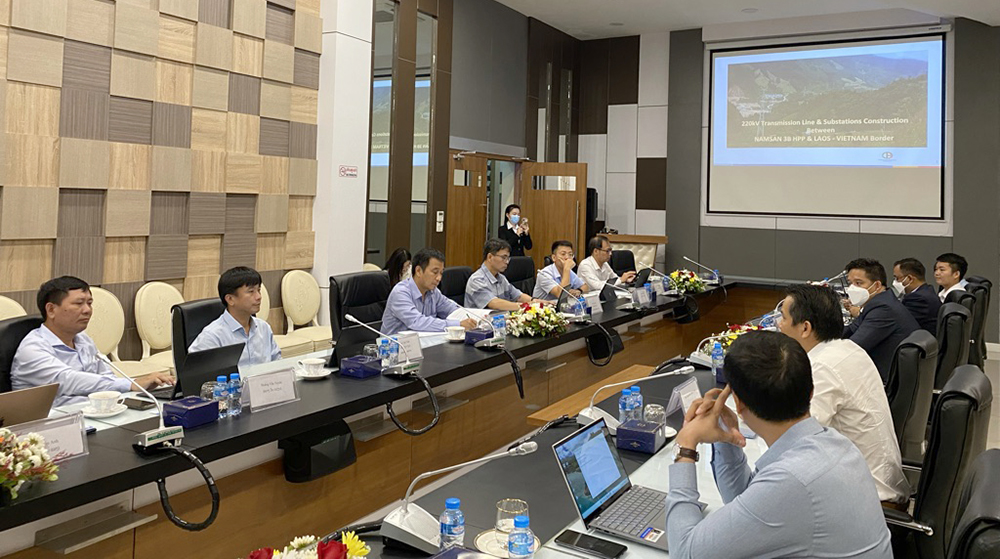
Mr. Nguyen Tuan Tung - Chairman of Member Board of EVNNPT
Reporter: Could you tell me about the advantages of importing power from Laos for Vietnam?
Mr. Nguyen Tuan Tung: Laos is a country with the potential for hydropower and renewable energy (wind power, solar power) near the Vietnam border area, but the load of Laos is not high. From an economic-technical perspective, buying electricity from Laos is very cost-effective. Therefore, the Vietnamese Government has a policy on importing electricity and Electricity of Vietnam (EVN) has signed power purchase and sale contracts with partners who own large power sources in Laos.
Specifically, Northern Laos has a total potential import capacity of nearly 4,000MW for Vietnam. There is thermal power potential in Central Laos, including the 2,000MW Boualapha Thermal Power Plant, which is expected to be connected via the 500kV line to the Ha Tinh 500kV Substation. Power sources in Southern Laos are proposed to be imported to Vietnam with a total capacity of 3,329MW.

EVNNPT working with investors of power sources in Laos, August 2022
Reporter: How is the investment in power grid infrastructure to import electricity being implemented by EVNNPT?
Mr. Nguyen Tuan Tung: EVNNPT has been assigned by EVN to invest in many projects of electricity transmission grids from the border and the part in the territory of Vietnam, specifically:
The Northern Power Project Management Board is deploying the Nam Sum - Nong Cong 220kV transmission line (through Thanh Hoa and Nghe An regions), expected to be energized in the second quarter of 2023 to keep up with the demand for electricity generation and sale from partners in Laos. After the project is completed, Vietnam can import via this line with a capacity of over 500MW from Nam Sum hydropower complex (Northern Laos) to serve the socio-economic development of the northern provinces in Central Vietnam.
The Power Transmission Project Management Board is managing and operating the project of expanding and renovating Thanh My 500kV substation (Quang Nam) so that electricity can be imported from Monsoon Wind Power Plant via the Monsoon - Thanh My 500kV dual-circuit line. Monsoon is one of the largest wind power farms in Southeast Asia, with a total investment of nearly USD 1 billion (600MW capacity) located in Southern Laos, about 20 km from the Vietnam border.
In the future, EVNNPT will invest in another 220kV Nam Ou 5 - Dien Bien transmission line, put into operation in 2023 - 2024 to continue importing electricity from Northern Laos, and so on.
Reporter: How do you evaluate the cooperation of Lao partners in recent times?
Mr. Nguyen Tuan Tung: The Lao partners have cooperated with the Electricity sector in a timely and open manner. In that spirit, the two sides have worked together very responsibly and effectively.
Specifically, Lao partners have signed power purchase and sale contracts with EVN. Recently, the delegation of EVNNPT came to Vientiane (Laos) to work with Impact Energy Asia Development Limited (IEAD) - the investor of Monsoon wind power plant to furnish the construction investment to build the Thanh My 500kV substation expansion project in order to soon bring electricity to Vietnam.
The delegation of EVNNPT also worked with Phongsubthavy Group, the investor of Nam Sum hydroelectric power plant cluster and many other hydropower plants in Laos. The Lao partner committed to coordinate and exchange necessary information with EVNNPT actively; At the same time, it was affirmed that they would speed up the construction of transmission grid infrastructure close to the border (the part of Laos) so that power could be energized through the North Central region of our country in the second quarter of 2023.

220kV Xekaman 1- Pleiku 2 line transmits power from Laos to Vietnam
Reporter: In your opinion, what is the potential for energy cooperation between Vietnam and Laos in the future?
Mr. Nguyen Tuan Tung: Vietnam and Laos should have a national grid connection system, because currently there is a cross-border connection system between the two countries, but only connected adjacent power sources to Vietnam.
With Laos’ geographical location near Thailand, Cambodia, and China, the connection between Vietnam’s grid and Southeast Asian countries will be more convenient. This is also an inevitable trend in the context that the capacity of renewable energy sources in Vietnam’s electricity system is increasing and bears unstable characteristics, requiring additional power sources once solar power cannot be generated. For example, the Monsoon – Thanh My 500kV line will help to harmonize the demand for electricity generation and consumption between the two countries as at the peak of the monsoon season, the wind power can be generated in Laos, but not in Vietnam, so we can import electricity through this line. Or vice versa, when in the flood season in Vietnam, power can be generated with a large power source, then it can be exported to Laos.
PV: Thank you, sir!
evn.com.vn
Share